by Elizabeth Cunningham
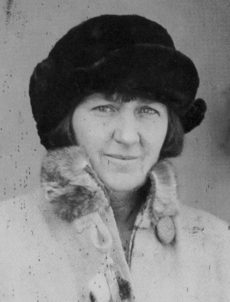
Collection Mabel Dodge Luhan House
This year marks the 138th anniversary of Mabel’s birth on February 26, 1879. Interestingly, the Mabel Dodge Luhan House has celebrated her birthday on special occasions since 1979. That year then owners George and Kitty Otero threw her a centennial party. Advertised in The Taos News, the event was listed under “Banish Winter Blues.” In the 1990s, Mabel House management continued the tradition with occasional lively dinner parties.
More recently two salons honored Mabel. On February 26, 2011, biographer Lois Rudnick hosted an “evening”. It included a dramatic reading of Mabel’s “The Change” by actress Leslie Dillen, followed by servings of a raspberry chocolate birthday cake and a booksigning of the newly released Mabel Dodge Luhan in Her Own Words.
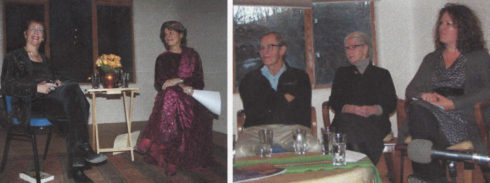
L: “Evening” with Lois Rudnick and Leslie Dillen as Mabel; R: Who’s Been Sleeping at Mabel’s? panel – L-R John Nichols, Rena Rosequist, Zoe Otero
The following year “Who’s Been Sleeping at Mabel’s” featured observations from three eras of Mabel House ownership. Lois spoke to Mabel’s time followed by Charlotte Hopper and Zoe Otero, speaking on behalf of the successive two owners, Dennis Hopper and George and Kitty Otero. Comments by writer John Nichols and long-time gallery owner Rena Rosequist rounded out the salon with hilarious and intriguing historical anecdotes.
Last year, Mabel’s birthday coincided with the publication announcement of Mabel Dodge Luhan & Company: American Moderns in the West.That book showcased the artistic output of Mabel’s Taos guests from 1918 to 1947. It accompanied the exhibition by the same name that opened at the Harwood Museum of Art last May. (The show traveled next to Albuquerque. Closing there in January of this year, the final venue opens next month at the Burchfield-Penney Art Center in Buffalo, New York, Mabel’s home town.)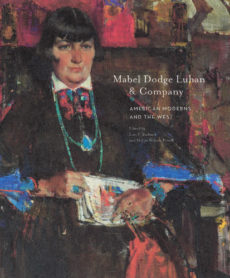
Still recuperating from all the Mabel & Company festivities, Mabel’s birthday slipped by us this year. Wondering how best to honor her, I thought of my recent research discoveries. Some tidbits have never been in print. Others—gleaned from Mabel’s full memoirs, Lois Rudnick’s volumes on Mabel, or from the Mabel Dodge Luhan Papers at Yale’s Beinecke Library—surprised me. What follows are glimpses of both Mabel’s life trajectory and her humanity. May these surprise you.
BUFFALO, NEW YORK: In her formative years Mabel clearly wanted something different in life than the one prescribed to women of the wealthy elite. In adolescence, when Mabel’s friend Esther Goodyear declared she wanted to be married and have children, Mabel said she didn’t. She aspired to be a hospital nurse—nurses were the only women she knew who were free and not married.
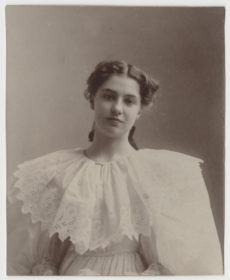
Young Mabel. Courtesy Mabel Dodge Luhan Papers, Beinecke Rare Book and Manuscript Library, Yale University
Around 1900, through her friendship with Buffalo’s prominent Cary family, Mabel met Arthur Brisbane. Sympathetic and understanding, the famous Hearst publisher drew Mabel out of her shyness. Asked what she wanted in life, Mabel confessed that she didn’t wish to marry nor did she want to stay in Buffalo. Did she want to work, Brisbane inquired. She wondered if she might work at his newspaper. He laughed. Mabel assumed that “women didn’t do that sort of thing then.” Nonetheless, she won a friend who thought she had brains.
NEW YORK CITY. Seventeen years later, New York Evening Journal editor Brisbane hired Mabel to write a syndicated advice column. City editors announced Mabel’s articles with captions like “Mabel Dodge Writes About Mother Love” and Mabel Dodge Asks ‘Do You Work for a Living’?” Previously, Mabel had written for Camera Work, Alfred Stieglitz’s avant-garde journal, and the progressive magazine, The Masses. These publications appealed to a limited audience. Writing for the Evening Journal in 1917, Mabel’s work, which appeared in every Hearst newspaper in the United States, reached millions of readers. She credited Brisbane with launching her career as a writer.
Mabel’s therapist A. A. Brill also played a role. Regarded as the man who helped shape American psychoanalysis, he had introduced Freud to modernists at Mabel’s salon. Born in Vienna, Brill was the first to translate Freud’s major works into English. When Mabel began therapy with him for her “melancholia”, Brill suggested she structure her life around meaningful work. She had experience in two arenas: writing and interior design. On January 13, 1917 she advertised her availability as interior design consultant in the New Republic.
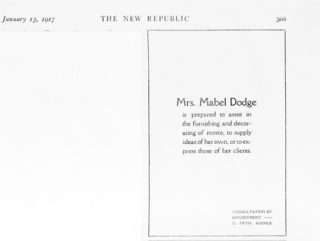
Mabel Dodge Luhan Papers, Beinecke Rare Book and Manuscript Library, Yale University
TAOS: Beginning in 1917 Mabel continued these two life pursuits with Taos as her muse. She she decorated her adobe home by combining furnishings brought from Italy and New York with carved wooden santos, Navajo weavings and other local arts typical of northern New Mexico. Mabel’s writing career blossomed. She authored six major books, published between 1933 and 1947.
As the Mabel and Company exhibition proves, Mabel brought luminaries to Taos who interpreted this era in northern New Mexico through the arts. This extension of her New York salon, another life pursuit, informed the national arts scene.
Less well known is Mabel’s contribution to the Taos scene. She funded the gazebo on Taos Plaza and donated the building that became the first hospital to the Town of Taos. She gave hundreds of books to the Harwood Foundation’s Library. She helped acquire farm machinery for Taos Pueblo, and provided replacement parts when threshing machines broke down.
Mabel also forged deep friendships with locals. Among her closest friends were Ralph and Rowena Meyers, the medical team of Dr. Ashley Pond and his wife Lou, and writer Frank Waters. Their remembrances follow.
In letters to Frank, Rowena reported on their mutual friend’s activities. In 1941: “Mabel has taken up bowling and enjoys the strenuous exercise, principally she says because it makes her perspire profusely.” A year later Mabel was “doing practically all her work, including the cooking. She [Mabel] said: ‘Imagine me, a woman of my age, just now learning how to cook. I asked the butcher what to do with the beef kidneys I bought, and he looked at me in amazement.’”
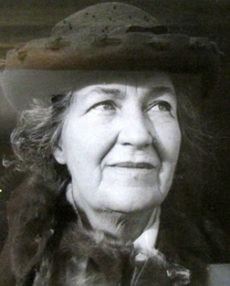
“Grandma Mabel.” Collection Mabel Dodge Luhan House
The Meyers and Pond family children adored Mabel. Ouray Meyers remembers her boosting him up onto the kitchen counter and feeding him graham crackers. His cousin Barbara McCarthy, nee Benavides, recounted Mabel lending her and Ouray’s sister lavish evening clothes and accessories so the little girls could play dress up.
Joan Pond supplied the following snippet on “Grandma Mabel”.
She was very good to us three girls as long as we had good manners and a willingness to be educated in all phases of life. She created a kindergarten in the little log cabin with Spud Johnson as a teacher. Stan Aiello taught art. When the weather was bad, we got to play upstairs in her bedroom. We brought binoculars from home and spied on the penitentes.
Happy Birthday, Mabel!